|
|
|
SUMMARY:
The Common Tern is present in very small numbers in Lough Allen and has shown an interest in nesting in 2 or 3 isolated locations... but not on existing rafts already on the Lake. They breed all around our coast and are increasingly to be found on inland waters. With a little bit of encouragement and protection they could be persuaded to settle in Lough Allen.
This is a noisy, exciting, attractive bird with agile flight and fast steep dives into water in pursuit of small fish. It is both dainty, colourful, and a strong flyer especially when after a marauding Gull! It requires a clean undisturbed lake and environment.
|
|
|
|
An on-going Study into one of the rare Species in Lough Allen’s Natural Biodiversity.
BIODIVERSITY = "the totality of genes, species, and ecosystems of a region" WIKI
SPECIES = “a group of organisms capable of interbreeding and producing fertile offspring.” WIKI
“If we lose this Species...
...we lose part of our Natural Heritage!”
|
Introduction
The Common Tern would be often regarded as a marine species but is common in many inland waters of Britain and Ireland. It could be a new and significant species in the Lough Allen basin. That is, if it is not an established or long present member of our fauna already? It is a very attractive species, very energetic and stimulating to watch and study. For quite a small bird it is both a higly skilled flier and also ferocious in protecting its nest and in driving off predators many times its size.
Over the past couple of years we have been studying these magnificent birds and this page will present that work and our photos to date and will be maintained as a record of this bird’s presence and survival in this environment in future years. It is a very marginal Summer visitor at present and is vulnerable to being eliminated if water quality or other conditions work against it. On the other hand, it is a species that can be easily encouraged and would, in a sense, act as a natural monitor for the quality of the Lough Allen environment and the way we care for our existing Natural Heritage.
Background

|

|
|
Our main intent is to portray this species in Lough Allen. But a short bit of background may be useful in introducing this bird. The best Web based source of Information is ARKive; just click on the picture at left for information on the Common Tern, (or the Logo above to go to their home page).
ARKive is an incredible International resource for biodiversity and information on a world of species. You will find any species we feature here on it. We just hope to add our little bit of local knowledge to their amazing work. Many thanks to them for this incredible resource and for allowing voluntary conservation/education projects draw on their files and videos.
|
|
The Common Tern in Lough Allen
Description
|
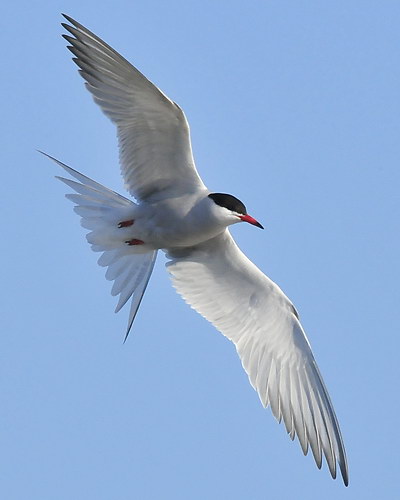
|
The Common Terns of Lough Allen
These are stunning birds — not very large but look impressive if they swoop down on you near their breeding grounds. They are fast, noisy, aggressive birds that are good nesters but open to much natural disturbance where they have chosen to breed in Lough Allen.
Being fish feeders they would also be vulnerable to any factors that damage the lake or its water. e.g disturbance of the shore by motor vehicles or development, deterioration of the quality of the lake through excessive floating rubbish, nets or other harmful synthetic material and, of course, by pollution of the water which seems inconceiveable in a peaceful rural setting — — but which can so easily happen if we do not take care!
In this description we point out the key characteristics which identify this species. There is no other species in Lough Allen with which they can be confused, apart from the Black-headed Gulls which are really quite different when studied at close quarters. The Terns are also much faster and more acrobatic flyers. They will chase after much larger predators and they will twist and turn and dive from a height when out fishing in the lake. Most of their food is obtained by diving into the water.
|

|
|
Many terns are maritime birds and there are similar looking species to be found around our coasts. The main species with which it can be confused is the Arctic Tern. This is quite similar in general pattern but has some key differences which can be appreciated if you get reasonably close and with binoculars. Arctic Terns have a shorter head and bill. The photo on the right shows the longer neck and bill characteristic of the Common Tern. Also, as can be seen on the left the outer primaries are dark.
|
|
The Tern family.
Terns are by and large sea birds. They are found all around our coasts. In Ireland the following species occur, some rarer and more local than others. (Check the ARKive link above for details on these species.) The Common Tern is the only one known to occur regularly on Lough Allen:
Common Tern
Arctic Tern
Roseate Tern
Sandwich Tern
Little Tern
World Distribution and Migration.
Tern species occur all around the world both at sea and in fresh water. They have some startling distributions and some stunning migrations. Our Common Tern breeds in central and northern Europe (but not the Arctic) and migrates to central or southern Africa in the Winter time.
Its cousin, the Arctic Tern lives in two discrete bands. It breeds in the Arctic south as far as the British isles, but it spends our Winters in a similar band but at the oppsite end of the world — all around the Antarctic! It is one of Nature’s long distance migrants.
The Roseate Tern is also a significant species for Ireland with a larger proportion of the world’s population breeding on a few colonies mainly on the east coast of Ireland. But it is not a species that travels inland.
|
This picture shows the profile of the Common Tern well... Long and sleek, very long and pointed tail feathers. But, unlike the Arctic Tern, this species has a bit of a neck, a slightly elongated head, and a bill as long as the head. The Arctic Tern has a shorter bill and a squatter neck.
Legs in the Common Tern are somewhat longer and the bird stands well clear of the ground.
|
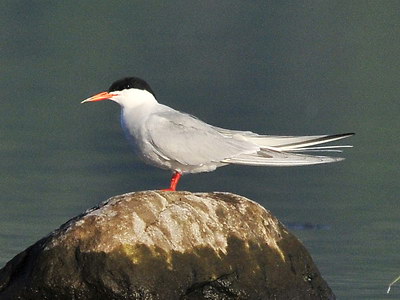
|
|
|
|
|
In this photo, note that this bird is a very strong flyer. Also very agile, as can be seen in photographs further down the page where we show images of it hunting and defending itself.
One of the best characteristics for identifying this species is the bill. Typically the outermost 1/3rd. is tipped with black whereas the Artic Tern is all red. But you need to be fairly close and have good light to assess this feature. However, you are unlikely to see an Arctic Tern on Lough Allen.
Another feature the books describe is the transparent inner primaries which can be seen from above and below the wing. Primaries are the main feathers on the outer half of the wing. In this photograph the six outer primaries show up as grey while the inner four are white. With the Arctic Tern the outer wing is very pale due to all the flight feathers (primaries) being transparent.
|
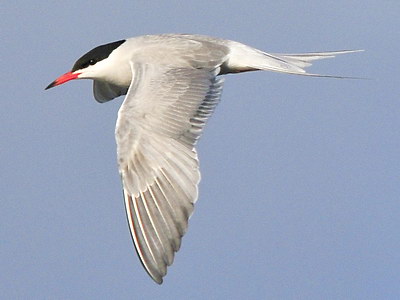
|
|
|
|
|
|
|
It looks like a mounted specimen in a Museum, but this photograph was actually taken on The Spit near Cormongan on Lough Allen. The bird is close to a shingle shore, in among low plants and adjacent to where this pair occupied a nest for about a month this year — unfortunately without success.
This photograph was taken from some distance and from a boat lying off shore and the bird was unconcerned about our presence.
Again the upright stance, the well proportioned neck, and the black-tipped bill can clearly be seen. The bright red legs are characteristic of most Irish terns in their Summer plumage, apart from the Sandwich Tern which is a strictly marine species.
|

|
|
|
|
|
Habitat
|
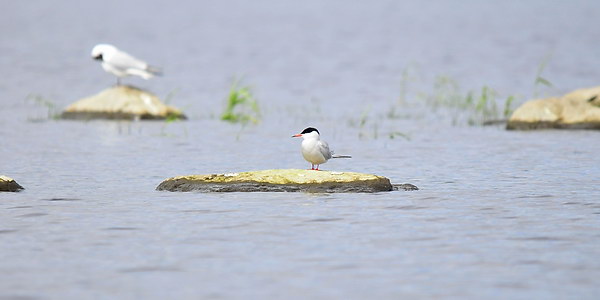
|
A Common Tern resting near its breeding site. This was one of a pair in 2011 and, when this photograph was taken (June 2nd), the pair were sustaining a nest in the grassy shingle nearby. Typically the other bird (and it’s impossible to say whether they were male or female) would rest some distance away but always keeping an eye on the nest site.
|
|
In western Europe, Common Terns are largely found along the sea coasts. In central Europe they breed in rivers and lakes and are widespread inland.
So far they are not very common on inland waters in Ireland but are quick to adopt new haitats and nesting sites. In Britain they are a common species in new habitats such as flooded quarries, gravel pits, and sewage treatment works.
It would be great to see these birds as a regular part of Lough Allen’s biodiversity. To us they seem exotic and a bit out of place in a large natural lake. But they are adaptable species and were well known for nesting in a coal yard adjacent to a power station in central Dublin — until that facility was closed down.
They basically need a secure nesting area and a good supply of fish or surface feeding invertebrates. They are not deep divers. Lough Allen is naturally well suited to them but we do not know their history in the area. They are quite visible especially during the migration season but their role as colonisers and a species that stayed around for all the breeding season may be a new development.
Certain natural and man-made factors do influence the future success of this species as a breeder in this area. They are not an endangered or a rare species in Ireland but they add a different and attractive element to our biodiversity and certainly Lough Allen has enough areas and habitats that could sustain a reasonable size breeding population.
Common Terns are very exposed to predation and disturbance from other members of the local fauna, especially Lesser Black-backed Gulls. We are in the awkward situation of having a species that is probably more in jeopardy than the Tern but which is an infernal nuisance to breeding Terns and other marginal species. The Gull, obviously, cannot be interfered with. Lough Allen has a very significant and often vibrant population of this species.
Significantly, this year (2011) weather caused a major change here and the Lesser Black-backed Gulls did not breed near The Spit (as they usually do) and this may have provided an opportunity for Common Terns to settle.
Both usual Black-backed Gull colonies seemed to have been abandoned in the cold weather in May and the only ones that bred did so on an outlining skerry off Corry Point, where no Common Terns have been seen landing.
The other problem facing the Common Tern is Lough Allen’s greatly fluctuating water levels. They can adapt to tides and regular changes but in Lough Allen the water may be very low for many weeks only to flood after the Terns might have laid their eggs.
This is a problem of our changing climate and the use of Lough Allen for hydro-generation. It also effects many other species, plants and animals. (e.g. The orchid, Spiranthes, and the Red-breasted Merganser.) Raised nesting sites on existing preferred areas seems more attractive than installing rafts due to the major predation and disturbance problem from the big Gulls.
|
|
|
|
|
|

|
This is part of The Spit taken at low water in 2010, looking south towards Inishfail and the Roscommon Hills.
The Spit lies about 1 km. south of Cormongan and is a long strip of shingle and boulders which can be quite extensive in the Summer but almost totally flooded in the Winter.
|
|
|
|
|
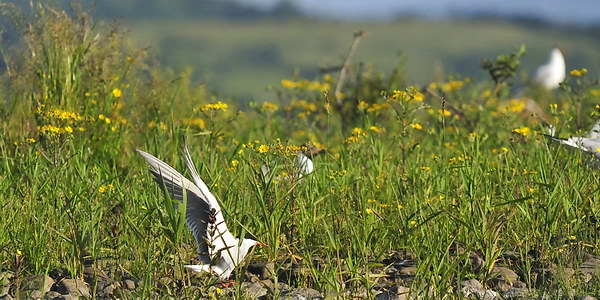
|
The lowest part of the shore is almost bare of vegetation as it is flooded for long periods of the year. When first seen scouting this site last year the Common Terns were attracted to a shingle area which would often have been flooded, even in the Summer. This year (2011) they moved to slightly higher ground and nested in among the permanent plants and small bushes.
|
|
|
|
|
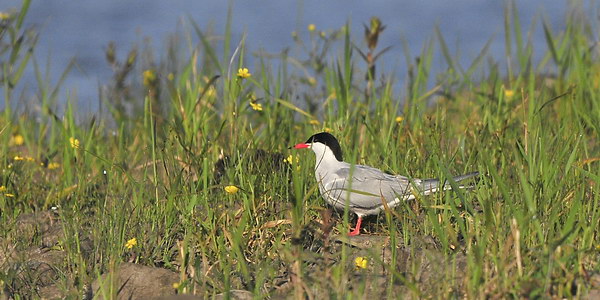
|
A wider habitat shot of the nest area. This seems well suited for Common Terns and they settled here. Using such areas, above likely flood waters, it may be possible to establish a breeding population in Lough Allen
Two existing rafts on the lake have not attracted Terns but are popular with Black-backed Gulls and Cormorants and this would discourage Terns.
|
|
|
|
|
|
|
Lesser Black-backed Gulls.
Cold Spring weather set these back and they weren’t such a problem to Common Terns and other species trying to breed around Lough Allen.
|
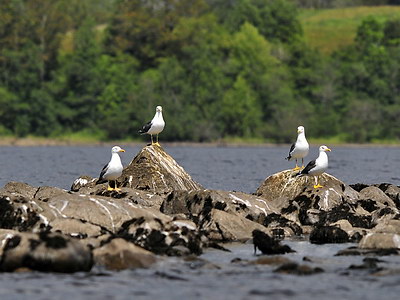
|
|
|
|
|
Territory & Pairing
|
All birds struggle hard to establish a nest site, a territory and a pair bond. In 2010, the first year we studied these birds on Lough Allen, there were five birds present (2 pairs) for much of the Summer.
In 2011 only one pair stayed constantly on The Spit though occasional other single or paired birds were seen at the north end of the lake in the Spring and at the southern end of the lake in the Autumn. This may not have been residents and could have just been migrating through.
We are convinced that this shoal of shingle and boulders just off the east shore of Lough Allen is the single best prospect for this exciting species to establish a foothold in this area. Its presence here, along with other rare members of our biodiversity, and the establishmnet of Hides and fair access to certain parts of the lake could be useful props in attracting further specialist tourism to the area. But for this to happen, and for our rich flora and fauna to survive, Lough Allen needs to be kept in a pristine condition.
These birds are primarily fish feeders and they need, as do our fishermen, to have a good population of small fish in the lake. That said, there is no evidence that even a big population of Terns would have any harmful effect on fish stocks. There are much worse predators around!
|
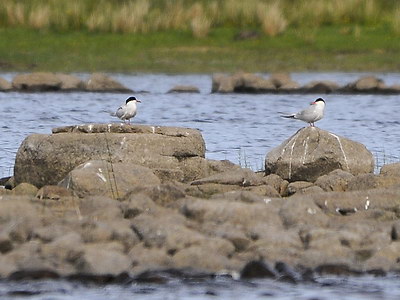
|
A pair of Common Terns, The Spit, Lough Allen, 2011
These were two of several terns that were active on this small shoal. During the Summer of 2010 terns were active on this shoal and adjoining islands but behaved in a different manner to the single pair occupying the site this year.
They stayed on off-lying rocks or else on the bare shingle and small cobbles towards the south end of The Spit, not venturing into the higher ground or longer grass of the more permanent dry ground of the island.
|
|
|
|
|
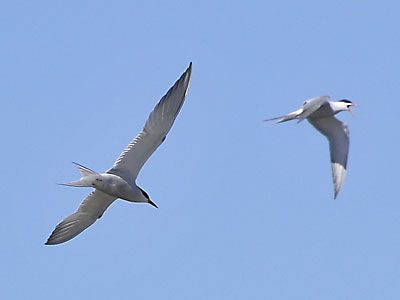
|
Perhaps because there was more than one pair the Common Terns were very active during 2010. They may have arrived late after the Black-headed Gulls had established themselves on the southern half of The Spit, and they might not have been able to establish a nesting site within that busy Gull colony.
Alternatively there was competition among the five Terns often seen here both for territory and for mates and this hindered them from settling down. The calling being done by the bird in the background is typical of either of these activities. Birds were well established but made no attempt to nest. But they were very aggressive and took on all large marauders that came near, especially the Lesser Black-backed Gulls — the bete noir to this species!
Lesser Black-backed Gulls bred succesfully on Round Island (1/2 km to the north) in 2010 (but not 2011). They were contunually patrolling the skiess over The Spit looking for eggs or other food.
|
|
|
|
|
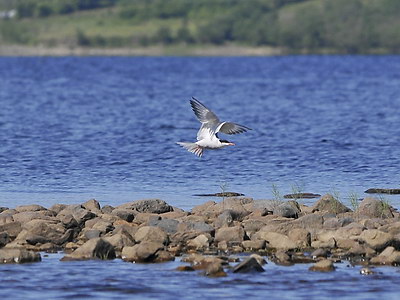
|
This photo shows the marginal rocks occupied by the Terns in 2010 and their jumpy behaviour — always keen to rise up and chase off some enemy.
Also, in the Autumn of 2010 birds were seen to explore a wooded island to the south (it has no name; we call it Jenny’s Island). This looked very like colonising behaviour — birds moving away from a contested location and seeing if there was anywhere esle suitable to breed in the following years.
This activity was not continued by the Terns in 2011. This may have been due to either, there being only one pair present, or the fact that the marauding L:esser Black-backed Gulls had moved away from the scene!
|
|
|
|
|
|
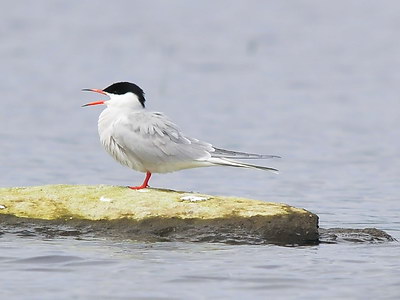
|
One pair of Common terns nested on The Spit this year. This may be the pair (though it could be the same bird). The anxious calling shown by the bird on the left was to his/her partner in the air driving off gulls! The bird on the left is definitely striking an attitude and would appear to be courting a female.
The bond between these two birds was amazing. Initially always close to one another and in the usual open terrain on the southern shore of The Spit but then establishing a nesting site further away from the water line, in among vegetation and close to Black-headed Gulls. They occupied this site for over a month and we presume they laid eggs as they returned to ‘incubate’ very quickly after they left the nest location.
|
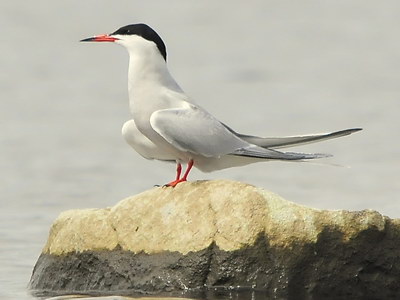
|
|
|
|
|
|
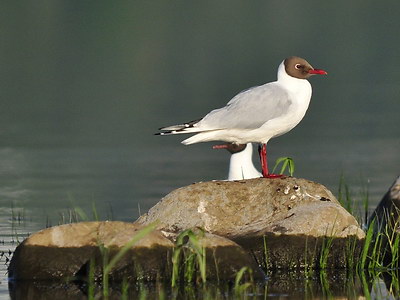
|
Birds compete for territory and food among their own kind and with different species. They also fight hard to drive off dangerous predators who will steal their eggs or young, such as the Grey Crow shown Left.
The Common Terns nested among a large colony (40 pairs) of Black-headed Gulls. Now these would not be predatory or aggressive to the Terns but they still live very close together and there would be competition for space as well as normal boundary wars between neighbours.
However, the location on higher ground, and in among a not so aggressive species, seems to afford the very exposed Terns a degree of protection and a possibility to fledge young in future years.
|
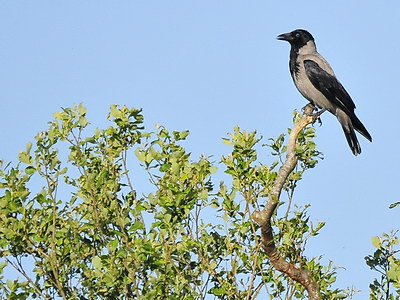
|
|
|
|
|
Fight and Flight
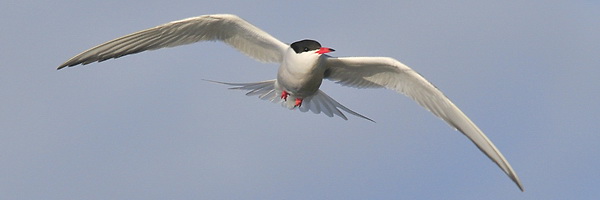 |
|

|
These birds are amazing flyers. To be near a Tern colony on a Summer’s day is amazing experience. However, it is important not to disturb these birds during the breeding season. We are very conscious when trying to show the rich diversity of life in Lough Allen that we do not ourselves hinder or impede that life.
The pictures of Terns in this section show some of them in attack mode. All these photos have been taken with a long lens from a small boat and the aggression being showed by these Terns was not aimed at us but at protecting their nesting site. Never once did the ‘bomb’ us as this species is inclined to do if you go too close. The will actually peck the top of your head!
These three pictures show a single Common Tern lining up an attack against a poor helpless Black-headed Gull. The top photo shows the Tern starting to head downwards. Left, and he has gained speed.
The tail feathers are used for many functions in flight. These birds can almost hover (like a Kestrel) when looking for fish. In this situation the tail will be spread and turned downwards to act as a break. The tail is also widely spread to make sudden twists and turns.
The Photo on the right shows the Tern at high speed coming up to a Black-headed Gull and scaring it away. The Tern is pulling up and has its tail feathers closed, presumably to allow it to fly faster in a straight line!
|
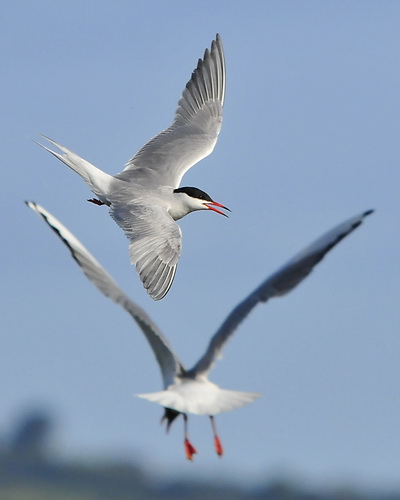
|
|
|
|
|
|

|
Two pictures of Common Terns in straight and level flight. Picture on the left is normal flight with deep and straight wing strokes. It is reasonably slow and persistent and this bird is on a journey, going fishing or flying to another island.
The bird on the right is putting on a turn of speed and does this by thrusting its wings forward and pulling strongly backwards. The emphasis is is on gaining forward momentum rather than constant steady flight. The Tern was building up for an attack!
|

|
|
|
|
|
|
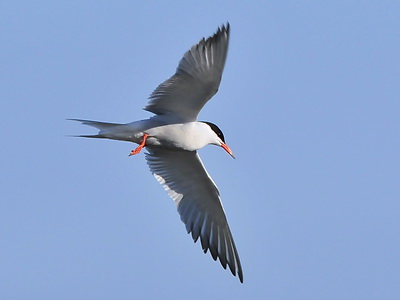
|
Two birds in survey mode. These photographs were taken over the colony but the postures taken are similar to those used while fishing; Common Terns typically fish by cruising over the water in a horizontal flight between 5m and 10m above the water. When they spot a fish they then start to dive and accelerate rapidly entering the water head on with wings and tail folded.
The bird shown in these photogrpahs was watching over its nesting area where its mate was occupying a nest. They were ready to rapidly atttack any intruder who might be seen as a threat to their mate.
|
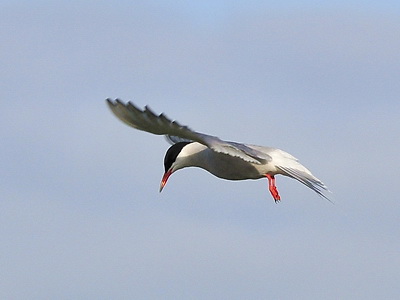
|
|
|
|
|
|
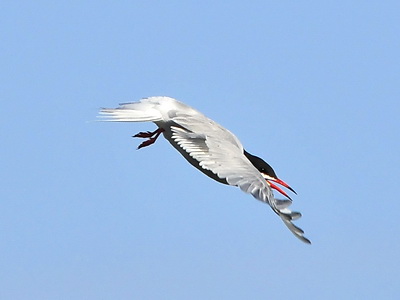
|
Switching into attack mode and heading groundwards. These Terns are driving off a Black-headed Gull. They do not seem to complete attacks on Black-headed Gulls. Is this because they are not really an enemy or a threat, or is it because the Gulls are small and adept and can jink out of the path of the oncoming Tern at the last minute.
There is a lot of competition for breeding space between thes two species and this may also contribute to increased hostilities we noticed this Summer. In 2010 the main target for attack by the Common Terns was the Lesser Black-backed Gull, but these abandoned their nearby colony this year and moved further and less successfully north.
Both of the Black-backed Gulls are voracious predators and will patrol over other gull colonies and quickly land to steal any eggs left abandoned. However, the patrolling by the Common Terns was certainly effective this year in driving away the few Lesser Black-backed Gulls that did turn up.
In 2010 the Tern population on The Spit was driven to distraction by the hourly visits by up to 20 Lesser Black-backed Gulls from their busy colony on nearby Round Island.
|

|
|
|
|
|
Nesting
 |
|
|
|
|
|
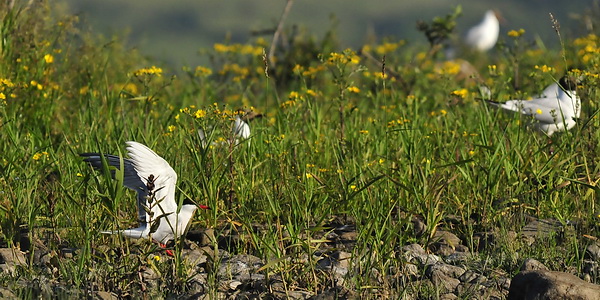
|
|
These series of photos show the area favoured by Lough Allen’s Terns over the past 2 years. Their history in the area, apart from being a migrating species is not known, and we would welcome any information about this.
Common Terns can be seen all around Lough Allen and adjoining lakes in the migration and Summer seasons, but never in large numbers. They have shown signs of prospecting one of the islands off Corry Point at the north end of the lake but we have never seen them holding territory there.
The only site they chose to nest on this year is The Spit. The photograph above shows the location of this shoal on the eastern shore and facing across to Arigna.
Common Tern, early in the year, landing near the nest site in among Black-headed Gulls. This was a daring exploit for this pair as they never settled here last year!
|
|
|
|
|
|
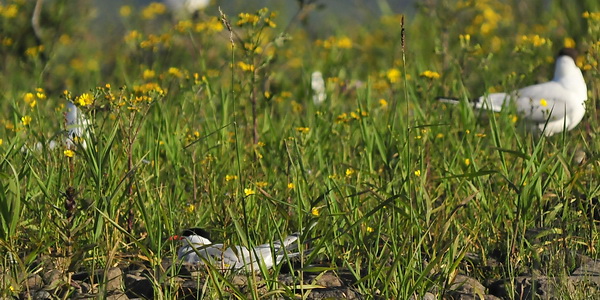
|
|
Common Tern sitting tight on the nest. This unusual sight was very satisfying this Summer. It was not the best Summer and many birds had difficulty breeding partially due to poor weather. (Lapwing, Mergansers, Lesser Black-backed Gulls)
But this pair of Terns settled down for the full month of June and only left the nest in turns to feed and defend the site. They were very impressive parents? Except they may not have produced any young. This picture may suggest we were very close and we could easily have checked for eggs. But we weren’t actually close and to go close could have caused an abandonment of the nest and destruction of any eggs.
By the time we felt it safe to visit the area the Terns were no longer sitting and the Gull eggs had mostly hatched. We saw no sign of the adult birds carrying fish into the area — though a bird was seen much later. (See below.)
|
|
|
|
|
|
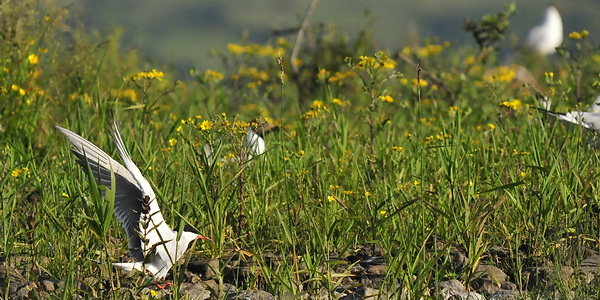
|
|
After a feeding or driving off enemies, the Terns very quickly homed back to this particular patch. There is no real nest , just a hollow in the ground. But when they came back they landed nearby, walked into the nest, looked around and then settled down low and stayed put peacefully. They must have been incubating?
|
|
|
|
|
|
Coming in to land...
|
|

|
|
|
|
|
|
Jumping up from the nest and flying off..
|
|
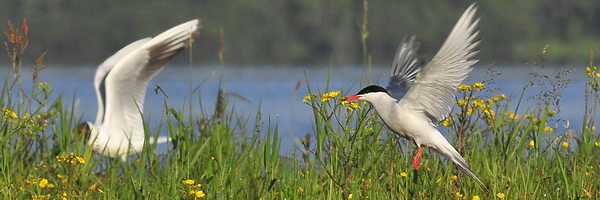
|
|
|
|
|
|
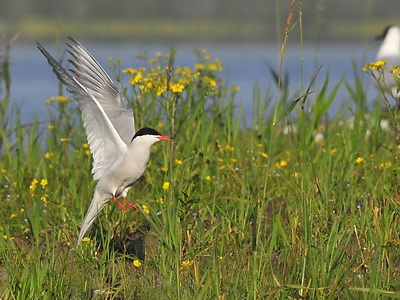
|
|
Here we reproduce three more studies of Lough Allen’s Common Terns.
The bird on the left is quickly leaving the nest. This often was initiated by a Gull or a Crow flying low overhead. Even the Black-headed Gulls, who are neighbours and not much harm, triggered this response if they came too close.
However, in all our vists here, we believe these birds would have been able to hatch eggs but we have no proof that this happened. They attended the site and there was a strong commitment from both adults.
|
|
|
|
|
|

|
|
This interesting photograph was taken near Holly Island just north of Drumshanbo. It shows an adult Common Tern carrying a fish in a very fast and business-like manner north up the lake. i.e. in the direction of The Spit. But this was the end of July and the nesting terns had not been seen on The Spit for a while.
This behaviour, and the manner of flight, is typical of Common Terns feeding young back at a colony. They go out to sea (or wherever they can find fish) often to shallow water and not too far from the colony. At a busy time of the year they can then be seen one after another coming back to the colony from the fishing ground carrying small fish back to their youngsters. A surprising sight to see in Lough Allen at the end of the Summer.
It is, of course, possible that the young had indeed successfully hatched and had eluded us. That would not have been all that difficult as young of gulls and terns can leave the nest very soon after hatching and take cover among rocks and vegetation from predatory birds flying overhead.
Also, providing food for a mate is part of avian courtship, typically in the Spring but it can be initiated again towards the Autumn after the breeding season. Whatever the reason, a very rewarding site. A sign of a strong biodiversity and a fairly clean ecosystem!
|
|
|
|
|
|
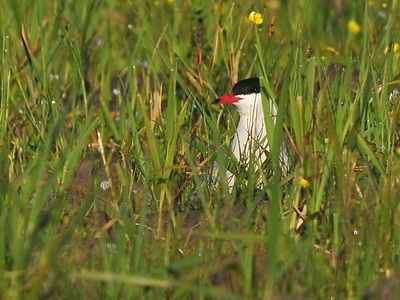
|
|
Just a portrait of one of the pair ‘on duty’ on a wet Summer’s day. This period of the Summer was suitable for breeding marine birds as the water level remained low, with only occasional light rain, nor were the days too cold.
Other species, which attempted to breed earlier, seem to have experienced difficulties and abandoned nests during the very cold month of May (2011). This may have been a factor in causing the Lesser Black-backed Gulls to abandon their normal breeding colony to the north of The Spit. Mergansers were also seen out on the Lake rather than sitting on eggs during the early Summer but one pair did successfully hatch. (More details to come in a special Merganser Species Study!)
|
|
|
|
|
|
|
|
|
 |
|